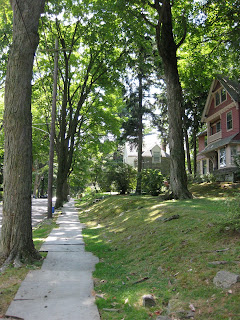There's no place like home. We're going to be on the road for a while, so I thought I'd walk around the neighborhood taking pictures so that when I mention something about my home in the future, you'll all have an exciting visual to reference. Also it's crazy nice out and I didn't feel like doing any real work.
I live in Mt. Airy, which is a neighborhood in Philadelphia. It's about twenty minutes outside of the center of Philadelphia, and was the first place in North America to grow cauliflower. It was also a good place to flee to in 1793 during the Yellow Fever. We're very proud.
Every morning Mark heads into Center City on the train. This is the Mt. Airy Station.
 Cynthia and Greg from Walk A Crooked Mile Books, nonchalantly reading a book together that happens to be the book that I wrote. They had no idea that I was taking this picture. Because I am super-sneaky.
Cynthia and Greg from Walk A Crooked Mile Books, nonchalantly reading a book together that happens to be the book that I wrote. They had no idea that I was taking this picture. Because I am super-sneaky.In what was once the Stationmaster's quarters of the Mt. Airy Station there is a used bookstore called Walk A Crooked Mile Books. In addition to being a fantastic bookstore, Walk A Crooked Mile is the gathering point in our neighborhood for summer concerts, yard sales, and people who need to take a train. It is also an excellent place to find great reads, provided that you love used bookstores, which I do. And it's the best kind of used bookstore--in addition to having stacks and stacks of books in little hidden rooms that you can get wonderfully lost in, Cynthia and Greg will offer you a free cup of coffee or tea or even cocoa just for browsing. And if you specify some sort of wacko obscure tea that you'd like, they'll probably have it.
 View of the store from the stairs up to the second floor.
View of the store from the stairs up to the second floor. View of the store from another part of the store with more books.
View of the store from another part of the store with more books. They're not kidding about the bathroom. There's a toilet behind the curtain.
They're not kidding about the bathroom. There's a toilet behind the curtain.I love a place that's jam-packed with books. It makes me happy.
This is the main commercial drag of Mt. Airy--there are little pockets of stores and restaurants elsewhere, but this is where the possibility of traffic exists.
This is the main commercial drag of Mt. Airy--there are little pockets of stores and restaurants elsewhere, but this is where the possibility of traffic exists.
 There were once trolleys that would take riders from Mt. Airy as far as South Philly, but now we use buses. It takes a little over an hour.
There were once trolleys that would take riders from Mt. Airy as far as South Philly, but now we use buses. It takes a little over an hour.  One of the best pubs in Philadelphia. I would have gone inside to take pictures, but apparently they're not open at ten in the morning. I'll just have to go back.
One of the best pubs in Philadelphia. I would have gone inside to take pictures, but apparently they're not open at ten in the morning. I'll just have to go back. Earth, Bread & Brewery. They don't have pizza. They have flatbread with stuff on it. I know, it sounds annoying, but the food is really good. Especially the Seed flatbread. Order that.
Earth, Bread & Brewery. They don't have pizza. They have flatbread with stuff on it. I know, it sounds annoying, but the food is really good. Especially the Seed flatbread. Order that. Creshiem Cottage, the oldest building in Mt. Airy.
Creshiem Cottage, the oldest building in Mt. Airy. The Sedgwick Theater.
The Sedgwick Theater. Our local Wawa.
Our local Wawa.I didn't know what a Wawa was before I moved to Philly in 1999, and when I first walked in, I thought it was pretty much just like a 7-11. NO, I was told, IT'S SO MUCH MORE. It's a 24-hour convenience store/deli where everything is inexpensive and good. Nothing is amazing (what do you want, it's open 24 hours and cheap) but everything is solidly good. Whenever we go out of Wawa range, we feel lost and sad, and whenever we see a Wawa again, we know we're close to home. I just looked for a map of where all the Wawas are and found this website--
Wawa 2010
So I know that my love for Wawa isn't totally insane. Or at least that I'm not alone in my totally insane love for Wawa. And Wawa loves us back.
Moving off the main drag, some examples of Mt. Airy architecture. Most of the homes around here were built somewhere between 1890 and 1940--our house was built in 1925 (and rehabbed two years before we moved in, thank goodness, because we have actual closets). A lot of the homes are made with Wissahickon schist, this gray, sparkly rock that was quarried not far from here. We have rowhomes and twins and single homes. It's a fun place to walk because every house is a little different.
 People here are really into their gardens. I'm a little suspicious of sunflowers (there's a reason, I'll save it for a rainy day) but I'm always impressed by what Mt. Airyans can do with a small front yard.
People here are really into their gardens. I'm a little suspicious of sunflowers (there's a reason, I'll save it for a rainy day) but I'm always impressed by what Mt. Airyans can do with a small front yard. I'm pretty convinced that gnomes live in this one.
I'm pretty convinced that gnomes live in this one.One of my favorite weird little quirky stories about Mt. Airy has to do with this row of houses on Allens Lane. At one point there was a frontage tax on new homes built on this road. In order to minimize it, or avoid it entirely, the Spite Houses were built.
 The front of the Spite Houses.
The front of the Spite Houses. A path leading to the backs of the Spite Houses.
A path leading to the backs of the Spite Houses. The backs of the Spite Houses. Aren't they neat?
The backs of the Spite Houses. Aren't they neat?There's more to see, but I'll save it for another beautiful day.







































